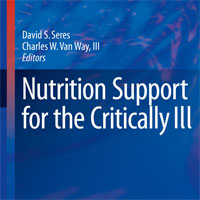Tag: malnutrition
Unlocking the Predictive Power of Nutritional Scores in Septic Patients
This study highlights the significant prognostic utility of nutritional status evaluation in septic patients admitted to internal medicine wards. Among the tools evaluated, the mNUTRIC score—likely because of its dual... read more
Higher Protein Dosing in Critically Ill Patients with High Nutritional Risk
Delivery of higher doses of protein to mechanically ventilated critically ill patients did not improve the time-to-discharge-alive from hospital and might have worsened outcomes for patients with acute kidney injury (AKI)... read more
Nutritional Risk Screening and Body Composition in COVID-19 Patients
Present findings confirm the clinical utility of NRS-2002 to assess nutritional risk in patients with COVID-19 at hospital admission and in predicting LOS, and that bioimpedance does not seem to add further predictive value.... read more
Tailoring Nutrition Therapy to Illness and Recovery
Without doubt, in medicine as in life, one size does not fit all. We do not administer the same drug or dose to every patient at all times, so why then would we live under the illusion that we should give the same nutrition... read more
Long-term Health Consequences of Under- and Over-feeding in PICU
Energy is essential for the treatment and recovery of children admitted to Pediatric Intensive Care Units (PICU). There are significant immediate and long-term health consequences of both under- and over-feeding in this population.... read more
Nutrition Support for the Critically Ill
This text provides a review of the current knowledge in both the mechanics of nourishing the critically ill and the metabolic and immunological roles nutrients play. In-depth chapters discuss disease-related malnutrition... read more

Nutrition in Surgery Podcast
Changing Care to Improve Surgical Outcomes. In this mini-series of six podcasts sponsored by Abbott Nutrition, the DCRI's Paul Wischmeyer, MD, EDIC, welcomes distinguished scientists and clinicians from the U.S. and the U.K.... read more
New research shows why nutrition should be back on the table for surgical patients
More than 48 million people in the U.S. undergo surgery each year, and for decades the focus has been on making sure patients do not consume any food or drinks in the hours leading up to the surgery. Yet, 1 in 3 patients... read more
The Role of Nutrition in Strong for Surgery
Host Paul Wischmeyer is joined by Thomas Varghese, MD, section head of General Thoracic Surgery at the University of Utah, to discuss the role of nutrition in the American College of Surgeons’ Strong for Surgery initiative.... read more
Trophic or Full Nutritional Support?
A two-phase approach for nutritional support may more appropriately account for the physiologic changes during critical illness than one-phase approach. Further evidence is awaited for the optimal protein amount during critical... read more
When Should Nutritional Support Be Implemented in a Hospitalized Patient?
At the time of admission to the hospital, malnutrition is already present in over 20% of patients. Hospitalized patients are particularly susceptible to developing malnutrition because of increased catabolic states in acute... read more
Enteral vs Parenteral Nutrition in Critical Care Requiring Mechanical Ventilation
Enteral feeding was not superior to parenteral feeding for early nutritional support in critically ill patients receiving mechanical ventilation and vasopressor support for shock, according to the results of a study published... read more
Nutrition Therapy – One Size Does Not Fit All
A review paper published in Critical Care highlights the importance of employing targeted nutritional care for critically ill patients. The sad truth, according to the article, is that current ICU nutrition delivery worldwide... read more
Hospitalist Tackles Chronic Disease With Food Pharmacies
Before January 2017, Rita Nguyen, MD, was "pretty much like any other academic hospitalist," she says. In the hospital, she could provide excellent care to patients, but once they were discharged, many didn't have the necessary... read more
Dietitians in Critical Care
Patients in the critical care setting are at risk of malnutrition. The provision of nutrition support (enteral or parenteral) to critically ill patients is vital, but achieving the optimum quantity and balance is a contentious... read more
Tenfold increase in childhood and adolescent obesity in four decades
The number of obese children and adolescents (aged five to 19 years) worldwide has risen tenfold in the past four decades. If current trends continue, more children and adolescents will be obese than moderately or severely... read more
Current Clinical Nutrition Practices in Critically Ill Patients in Latin America
In the ICU setting in Latin America, malnutrition was highly prevalent and caloric intake failed to meet targeted energy delivery in 40% of critically ill adults receiving nutrition therapy. Supplemental administration of... read more
Most ICU Patients Underfed
A large international multicentre cohort study shows that most of the patients are underfed during their ICU stay. In their findings published in the journal Clinical Nutrition, researchers say most of the patients in intensive... read more
The Science and Art of Pediatric Critical Care Nutrition
Malnutrition is prevalent in the pediatric ICU population, and is associated with worse outcomes. Nutrition support teams, dedicated dietitians, and educational programs facilitate surveillance for existing malnutrition and... read more
Malnutrition, Critical Illness Survivors, and Postdischarge Outcomes
The exposure of interest was malnutrition determined at intensive care unit (ICU) admission by a registered dietitian using clinical judgment and on data related to unintentional weight loss, inadequate nutrient intake, and... read more









